The technological framework is laid to track and trace every person, purchase, and protein on the planet with the potential applications of invasive technologies championed by the World Economic Forum’s great reset agenda.
People who know they are being constantly monitored behave differently than those who don’t.
In today’s digital world, almost every citizen is aware that their online activity is being monitored, but not everyone knows the full extent, nor are they fully conscious of how track and trace surveillance can manipulate their behavior.
“Authoritarianism is easier in a world of total visibility and traceability” — WEF Global Risks Report, 2019
For those in the “too long; didn’t read” category, here are some key observations dissected in this article:
- The Preamble: Tracking and tracing can be complementary to transhumanism by way of biometric sensors that can be implanted in the human body, and/or via synthetic, biological alterations to farm and lab-grown food that people eat
- The People: Tracking and tracing people in real-time via smart devices, wearables, and implants (Internet of Bodies [IoB]) can allow intimate health, geolocational, and behavioral data to flow between public and private entities, which can grant access to, or restrict a person’s ability to use essential goods and services
- The Purchases: All financial transactions can be tracked and traced digitally (Central Bank Digital Currencies, Distributed Ledger Technology), and the power to purchase/access essential goods and services can be altered for any individual at the flick of a virtual switch
- The Protein: Food grown in farms or labs (Traditional and Alternative Proteins) can be tracked and traced along the supply chain where every ingredient that a citizen consumes can be monitored and accounted for, while biological alterations to the food source itself may have the potential to change gene function on the opposite end of the pipeline
- The Possibilities: The ability to fundamentally alter what it means to be human can be achieved through biological and/or technological means. All data (anonymized, compartmentalized, or otherwise) can be consolidated into a digital identity that is unique to each individual, which can give public and private entities unfettered access and insights into the mind, body, and spirit of every person on the planet, who can then be manipulated, coerced, or incentivized into changing their behavior
This is how public-private collaborations are technologically able to track and trace every person, purchase, and protein on the planet and manipulate human behavior.
The Preamble
On the surface, the WEF agenda appears benevolent in its desire to tackle some of the greatest challenges of our time, but the solutions it proposes via a great reset of the global economy and societal contracts have all the ingredients necessary for techno-totalitarian world governance.
Behind every publicly-facing good intention to tackle whatever crisis-of-the-month it decides to focus on (i.e. COVID-19, climate change, digital exclusion, poverty, etc.) lies a framework that has the potential to lead humanity down a path of complete authoritarian control over the whole of society.
“Citizens willingly gave up some of their sovereignty–and their privacy—to more paternalistic states in exchange for greater safety and stability” — Rockefeller Foundation hypothetical pandemic scenario, 2010
With agendas such as the merger of humans and implantable devices (transhumanism and the IoB), the adoption of centralized ledgers for every financial transaction (digital currencies), and the application of sensors embedded in farm and lab-grown proteins (food traceability and synthetic biology), every person, purchase, and protein on the planet can now be tracked and traced.
Data pertaining to the most intimate details of our lives can be shared across interoperable public-private databases and platforms, and in combining massive biometric data with supercomputing power, humans have become fully hackable, which means our behavior can be manipulated physically, consciously, or subconsciously, to the whims of whomever controls the data.
The People
Contact tracing and vaccine passports are two recent incarnations of track and trace applications currently being used for mass surveillance and a restriction of citizen movements that threaten fundamental human rights.
The Internet of Bodies “might trigger breakthroughs in medical knowledge […] Or it might enable a surveillance state of unprecedented intrusion and consequence” — RAND Corporation, 2020
WEF Founder and Executive Chairman Klaus Schwab famously predicted that the Fourth Industrial Revolution would lead to “a fusion of our physical, our digital, and our biological identities” — transhumanism, in a word (see video below).
“What the Fourth Industrial Revolution will lead to is a fusion of our physical, our digital, and our biological identities” — Klaus Schwab, 2019
While contact tracing apps and vaccine passports launched in the COVID era have come in both digital and paper form, there is a growing ecosystem known as the Internet of Bodies that is fusing the human body with an abundance of sensors that can relay personal data across interoperable networks — a new era of transhumanism.
“It’s now time for the Internet of Bodies. This means collecting our physical data via devices that can be implanted, swallowed or simply worn, generating huge amounts of health-related information” — WEF Agenda, 2020
Before the term “Internet of Bodies” became the popular nomenclature, it was briefly referred to as the “Internet of Me” — both are terms that draw on the Internet of Things (IoT) concept and expand it to include the human body.
“The internet of me loosely refers to technology which connects our minds and bodies with the online world. It transforms our biological and cognitive life into streams of data which can be monitored, shared and shaped,” according to a WEF agenda post from 2015.
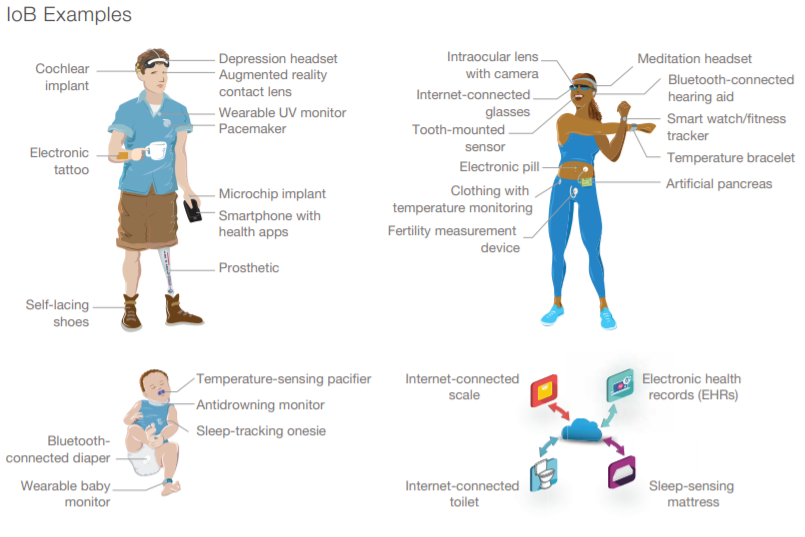
Internet of Bodies Examples, RAND Corporation
Accelerating the transhumanist agenda is the adoption of the IoB ecosystem.
According to a RAND corporation report published in 2020, an IoB device is defined as a device that:
- Contains software or computing capabilities
- Can communicate with an internet-connected device or network
- Satisfies one or both of the following:
- Collects person-generated health or biometric data
- Can alter the human body’s function, which refers to an augmentation or modification of how the user’s body performs, such as a change in cognitive enhancement and memory improvement provided by a brain-computer interface, or the ability to record whatever the user sees through an intraocular lens with a camera
The Internet of Bodies not only promises to track and trace what people feel, see, hear, touch, and taste, but the data gathered can be used to modify their behavior in both good and horrendous ways — depending on who’s doing the manipulating and for what purpose.
“The Internet of Me […] transforms our biological and cognitive life into streams of data which can be monitored, shared and shaped” — WEF Agenda, 2015
“With an unprecedented number of sensors attached to, implanted within or ingested into human bodies to monitor, analyze and even modify human bodies and behavior,” the RAND report recommends that “immediate actions are needed to address the ethical and legal considerations that come with the IoB.”
In June, 2020, WEF Fellow Xiao Liu declared, “It’s now time for the Internet of Bodies. This means collecting our physical data via devices that can be implanted, swallowed or simply worn, generating huge amounts of health-related information.”
“The deluge of data collected through such technologies is advancing our understanding of how human behavior, lifestyle and environmental conditions affect our health. It has also expanded the notion of healthcare beyond the hospital or surgery and into everyday life,” she added.
One major pitfall of the IoB, according to Liu, is that “data from the Internet of Bodies can be used to make predictions and inferences that could affect a person’s or group’s access to resources such as healthcare, insurance and employment.”
According to the WEF’s “Shaping the Future of the Internet of Bodies” report published in August, 2020:
“The adoption of wearables and IoB devices in employee wellness programs and in employment scenarios creates new concerns about employee privacy and workplace surveillance.
“With employers using devices and algorithms to monitor and direct employees’ movements, communication and behavior patterns, relatively weak regulations in this area offer limited legal protection.
“This can expose workers to higher risks of misuse of data and black-box algorithms that may lead to biased decisions regarding hiring, promotion and retention.”
“This digital identity determines what products, services and information we can access – or, conversely, what is closed off to us” — WEF report, 2018
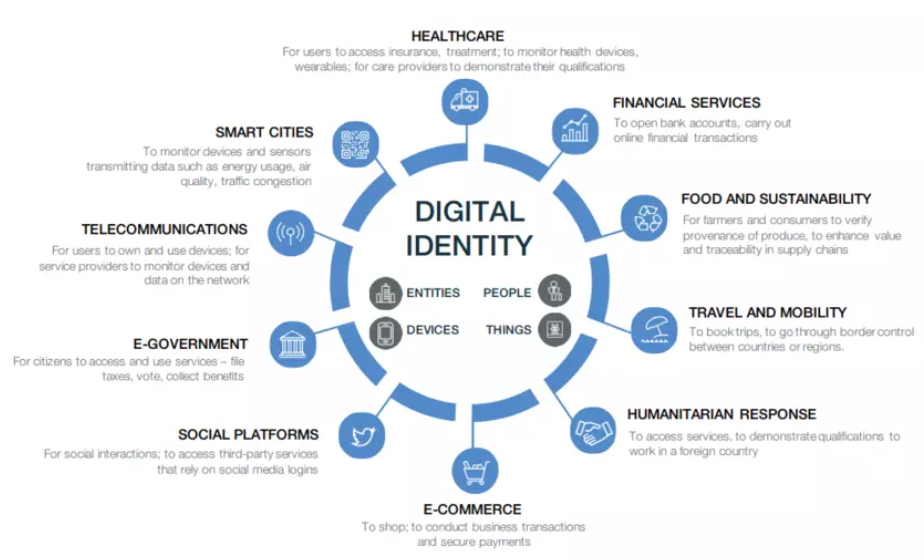
Image Source: World Economic Forum
The Internet of Bodies ecosystem was developed to track and trace people with the intent to manipulate behavior, and a recurring theme throughout this story is that a person’s private data can be pegged to their digital identity, which can then be shared with public and private entities that provide access to essential goods and services.
According to a WEF insight report on digital identity from 2018, “Our identity is, literally, who we are, and as the digital technologies of the Fourth Industrial Revolution advance, our identity is increasingly digital.”
Additionally, “This digital identity determines what products, services and information we can access – or, conversely, what is closed off to us.”
With data flowing from the IoB and pegged to a digital identity, a citizen’s access to essential goods and services, and their activities pertaining to financial transactions, can also be tracked, traced, and restricted — a prerequisite for manipulating human behavior.
The Purchases
Centralized digital currencies can allow central banks to track and trace the movement of all financial transactions, with outcomes that can manipulate, coerce, or incentivize human behavior.
When the Colonial Pipeline was hit with a ransomware attack in May, 2021, the private company almost immediately dished out nearly $5 million in Bitcoin.
Less than a month later, the US government was reportedly able to recover about $2.3 million of that cryptocurrency thanks to track and trace efforts made possible by the inherent properties of distributed ledger technologies.
In a hypothetical world where there is no physical currency, every purchase you make would be digital, and all financial transactions could be tracked and traced along the entire chain of custody.
“We applaud the efforts by the WEF in actively researching digital currencies […] to ensure that central banks can maintain their role as stewards of the economy” — WEF Agenda, 2020
In this futuristic scenario, which is becoming reality in places like Communist China and elsewhere, many types of fraud would be greatly reduced.
At the same time, Central Bank Digital Currencies (CBDCs) would also ensure that economic control would remain within centralized banking systems.
But like with any technology, trust comes from knowing how it’s used, and knowing who benefits the most from the people who use it.
“With a few tweaks of code, blockchain can be corrupted by authoritarians to build social credit enslavement systems,” Trent Lipinski warned in the Coin Telegraph.
“If world governments legislate encryption technology for their own purposes and pervert consensus mechanisms for their own centralized enslavement systems, we will end up with digital currencies that can be used against the people of the world,” he added.
“The [Central Bank Digital Currency] system will enable the Chinese Communist Party to exercise greater control over private transactions, as well as to wield punitive power over Chinese citizens in tandem with the social credit system” — CNAS report, 2021
The Chinese Communist Party has already created an Orwellian surveillance state that pegs the digital identities of its “netizens” to a social crediting system.
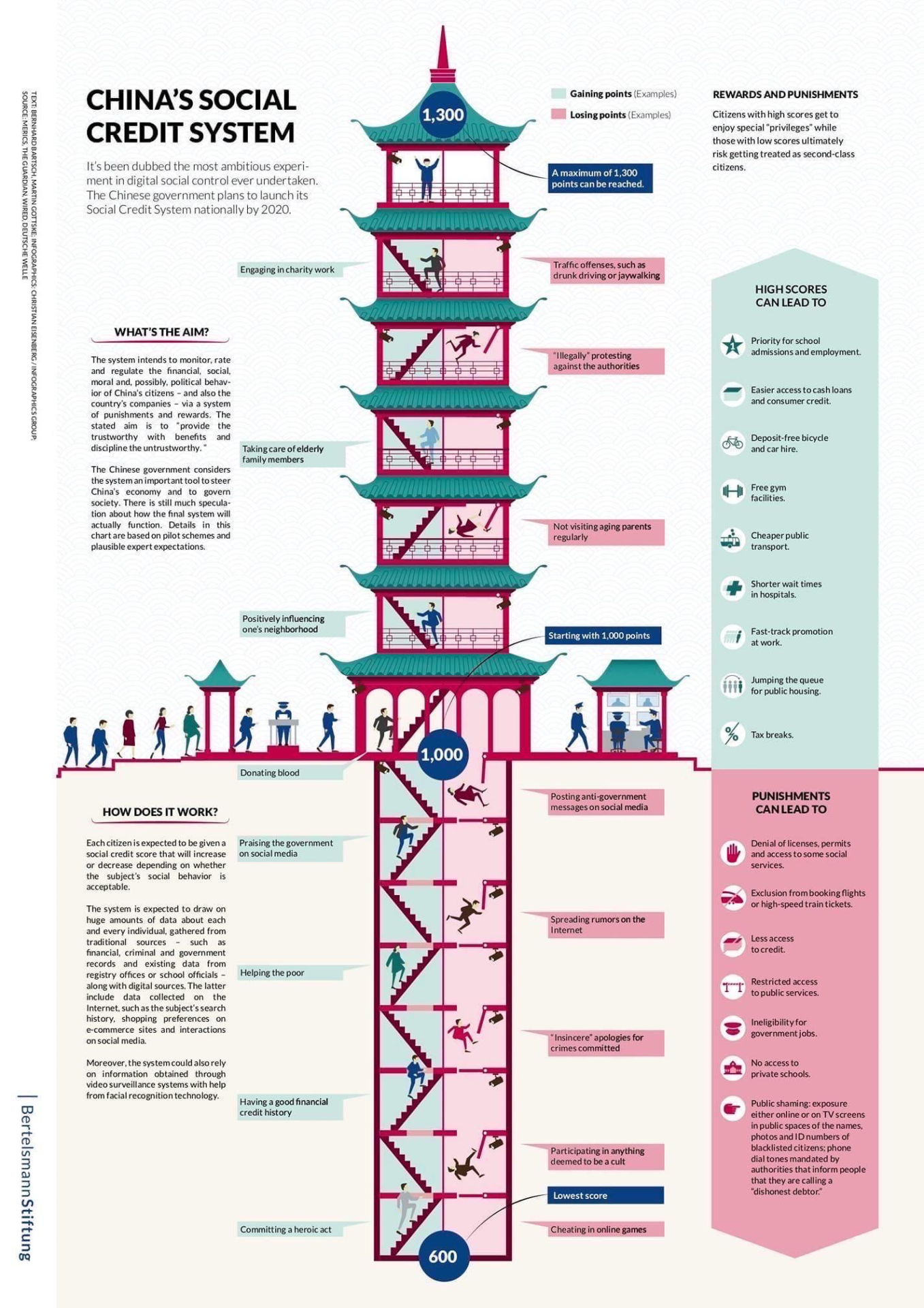
China’s Social Credit System
From “deadbeat debtor” contact tracing apps that alert citizens with a warning whenever they come with 500 meters of someone who is in debt to the DNA phenotyping of over 1 million Uyghurs sent to “re-education” camps — the CCP is a living example of some of the horrible ways in which digital identities can be exploited.
Under China’s nascent social credit system, citizens are given a credit score based on their online and offline behavior. It’s a system that rewards “good” behavior like spending time with the elderly while punishing “bad” behavior like protesting the government or spending too much time playing videogames.
When “trust” is broken in one area, restrictions are placed everywhere — meaning citizens who commit even minor infractions can be blacklisted from traveling, going to restaurants, renting a home, or even having insurance.
This has happened to over 30 million citizens, according to Chinese State-run media (video below).
In February, 2021, the Center for a New American Security (CNAS) issued a report on the development of Communist China’s Central Bank Digital Currency, highlighting the probability of the Chinese government exploiting the digital currency to further surveil, coerce, and control its citizens’ behavior as part of its larger social credit system.
According to the CNAS report, “This digital currency push is a major step in expanding the party’s digital authoritarianism, adding real-time financial data into the CCP’s strategy for technology-driven governance.”
The report goes on to say:
- The system will also enable the CCP to exercise greater control over private transactions, as well as to wield punitive power over Chinese citizens in tandem with the social credit system.
- In addition to basic information about users and transactions, it is possible that various metadata associated with users’ movements and devices could also be infused with such big data.
- The PBOC [People’s Bank of China] will become a possessor of a significant data trove to combine with its tools for censuring and surveilling individuals.
- The PBOC will likely be able to cut off access to DCEP funds in order to punish or coerce any user.
When the WEF announced the launch of the “Global Consortium for Digital Currency Governance” in January, 2020, ConsenSys Founder Joseph Lubin praised the WEF for helping to ensure that central banks could “maintain their role as stewards of the economy.”
“New technologies, like blockchain, have helped catalyze a revolution in the mechanics of money,” said Lubin.
“We applaud the efforts by the WEF in actively researching digital currencies, including those that are blockchain-based, as a means to foster innovation but also ensure that central banks can maintain their role as stewards of the economy,” he added.
Digital currencies, when centralized, have the potential to be tracked and traced and used in ways that can manipulate, coerce, and incentivize human behavior.
The Protein
The pieces have been set in motion to track and trace every protein on the planet, from the complete traceability of the entire cattle production chain and onward towards lab-grown meats, insect-infused comestibles, and plant-based proteins.
In his book, “The Fourth Industrial Revolution” published in 2017, WEF Founder Klaus Schwab notes that animals can be genetically modified, “so that they can be raised on a diet that is more economical.”
The list of potential [synthetic biology] applications is virtually endless—ranging from the ability to modify animals so that they can be raised on a diet that is more economical or better suited to local conditions” — Klaus Schwab, “The Fourth Industrial Revolution,” 2017
In one sentence, we see three overlapping scenarios:
- The genetic modification of protein
- The altering of living creatures to allow their bodies to accept unnatural diets
- The economic incentives for genetically altering living creatures to be raised on those diets
Major roadblocks currently impeding this from happening to humans include “the profound ethical issues,” which the WEF founder sets aside in his book.
Also in “The Fourth Industrial Revolution,” Schwab goes on to explain:
“[Synthetic biology] will provide us with the ability to customize organisms by writing DNA. Setting aside the profound ethical issues this raises, these advances will not only have a profound and immediate impact on medicine but also on agriculture and the production of biofuels.”
Schwab adds, “The ability to edit biology can be applied to practically any cell type, enabling the creation of genetically modified plants or animals, as well as modifying the cells of adult organisms including humans […] In fact, the science is progressing so fast that the limitations are now less technical than they are legal, regulatory and ethical.
“The list of potential applications is virtually endless—ranging from the ability to modify animals so that they can be raised on a diet that is more economical or better suited to local conditions, to creating food crops that are capable of withstanding extreme temperatures or drought.”
If animals can be modified to be raised on a diet that is more economical, couldn’t the same be applied to humans?
According to a 2016 report published in the Daily Mail, “If the production of protein is changed, it can have a knock-on effect on how our bodies grow, respond to illness and even our intelligence.”
“You will eat much less meat. An occasional treat. Not a staple” — WEF prediction for 2030
The WEF is pushing the agenda for people to consume less meat “for the good of the environment and our health,” according to one video that went viral last year.
The video below, “8 Predictions for 2030,” gained notoriety with its statement, “You’ll own nothing. And you’ll be happy.”
It also predicted, “You will eat much less meat. An occasional treat. Not a staple. For the good of the environment and our health.”
But the push to lower meat consumption is not just about public health and the environment; it’s an agenda for economical food distribution that can be tracked and traced with greater efficiency.
According to the WEF report on “Traceability in Food Value Chains” published in January, 2019:
“Meat is difficult to track consistently along the supply chain, because products sourced from different farms often commingle; new supply-chain processes and/or new types of individual identifiers may be needed to overcome this challenge.”
“Meat is difficult to track consistently along the supply chain” — WEF “Traceability in Food Value Chains” report, 2019
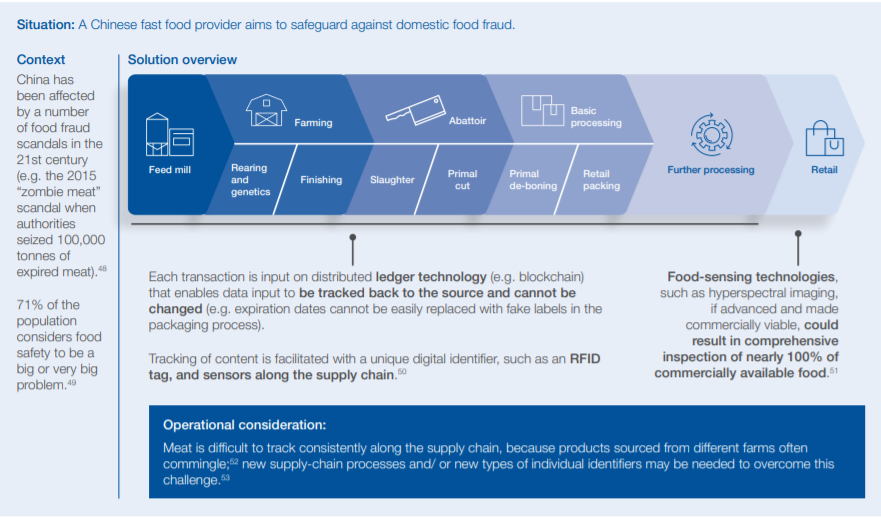
Source: Traceability in Food Value Chains, WEF
According to the report, the WEF sees the need to track and trace meat supply chains for another seemingly benevolent purpose: to “address susceptibility to food outbreak risks.”
“The combined implementation of IoT, distributed ledger technology and food-sensing technologies could also lead to significant improvements in food safety for low- and middle-income countries, which tend to have more food safety issues than their developed market counterparts,” the report reads.
However, as with everything the World Economic Forum touches, there must always be an economic motive to its methods, hence the globalist organization’s namesake.
Therefore, the WEF touts that the “adoption of IoT and distributed ledger technologies would improve the health of consumers and the bottom line of players throughout the food value chain, ensuring that only the contaminated product is removed from shelves rather than all similar products.”
“Innovation in traceability and labelling for both alternative‑and traditional‑protein products […] involving distributed ledgers and embedded microchips, present exciting opportunities to improve transparency” — WEF “Alternative Proteins” White Paper, 2019
But if meat is particularly difficult to trace, and the plan is to reduce meat consumption worldwide, what could serve as a meat substitute that’s easier to trace?
Enter alternative proteins.
Alternative proteins are produced in factories, farms, and labs where they can all be fitted with sensors hooked-up to the IoT for ultimate traceability stemming from centralized systems of control and surveillance. That’s one way of looking at them. Justifying land grabs of the world’s most productive farming lands is another.
Alternative proteins involve “purely plant‑based alternatives, products based on insects and other novel protein sources, and the application of cutting‑edge biotechnology to develop cultured meat,” according to the WEF’s White Paper on Alternative Proteins published in January, 2019.
“The ability to edit biology can be applied to practically any cell type, enabling the creation of genetically modified plants or animals, as well as modifying the cells of adult organisms including humans […] In fact, the science is progressing so fast that the limitations are now less technical than they are legal, regulatory and ethical” — Klaus Schwab, “The Fourth Industrial Revolution,” 2017
A month prior to the ransomware attack on the world’s biggest meatpacker, JBS acquired Europe’s third-largest plant-based food producer, Vivera, for a sum of $530 million (€341 million) in April, 2021.
JBS, which partnered with the WEF on climate change in April, owns enormous stakes in both the traditional and alternative protein markets, and the world’s largest meat supplier is also tracking and tracing its entire cattle production on the blockchain.
In April, 2021 JBS announced the launch its blockchain platform — dubbed the “Transparent Livestock Farming Platform” — with the purpose of tracing its entire cattle production supply chain.
What technologies are enlisted in food traceability?
Going back to the WEF’s 2019 White Paper on Alternative Proteins:
“Innovation in traceability and labelling for both alternative‑and traditional‑protein products […] involving distributed ledgers and embedded microchips, present exciting opportunities to improve transparency and communicate to consumers the multiple impacts of different food types.”
If lab-grown food and traditional animal proteins are to be tracked and traced with “embedded microchips,” is it possible for those embedded microchips to end up in our bodies, or would the technology be strictly limited to the physical packages?
“Any package, pallet or container can now be equipped with a sensor, transmitter or radio frequency identification (RFID) tag […] In the near future, similar monitoring systems will also be applied to the movement and tracking of people” — Klaus Schwab, “The Fourth Industrial Revolution,” 2017
Looking back at Schwab’s passages in “The Fourth Industrial Revolution”:
“Any package, pallet or container can now be equipped with a sensor, transmitter or radio frequency identification (RFID) tag that allows a company to track where it is as it moves through the supply chain—how it is performing, how it is being used, and so on.”
“In the near future, similar monitoring systems will also be applied to the movement and tracking of people,” he added.
Tracking and tracing every protein on the planet has the potential to manipulate human behavior by controlling and monitoring every ingredient we eat.
There is also the overlapping potential to genetically modify any living species for the purpose of allowing it to consume a more economical diet, as referenced by Schwab himself.
The Possibilities
The tracking and tracing of every person, purchase, and protein on the planet through public-private cooperation provides the potential for:
- The seamless merger of corporation and state (Corporatism and Fascism)
- The destruction of individual liberty, sovereignty, and ownership with group identity favored over individual responsibility (Marxism and Socialism)
- The emergence of global governance based on technological surveillance and control (Techno-Totalitarianism)
The notion of a top-down, techno-authoritarian response to a deadly pandemic was simulated long before the COVID-19 outbreak.
“Even after the pandemic faded, this more authoritarian control and oversight of citizens and their activities stuck and even intensified” — Rockefeller Foundation hypothetical pandemic scenario, 2010
In 2010 the Rockefeller Foundation issued a report called “Scenarios for the Future of Technology and International Development,” which simulated a fictional top-down authoritarian response to a hypothetical pandemic scenario.
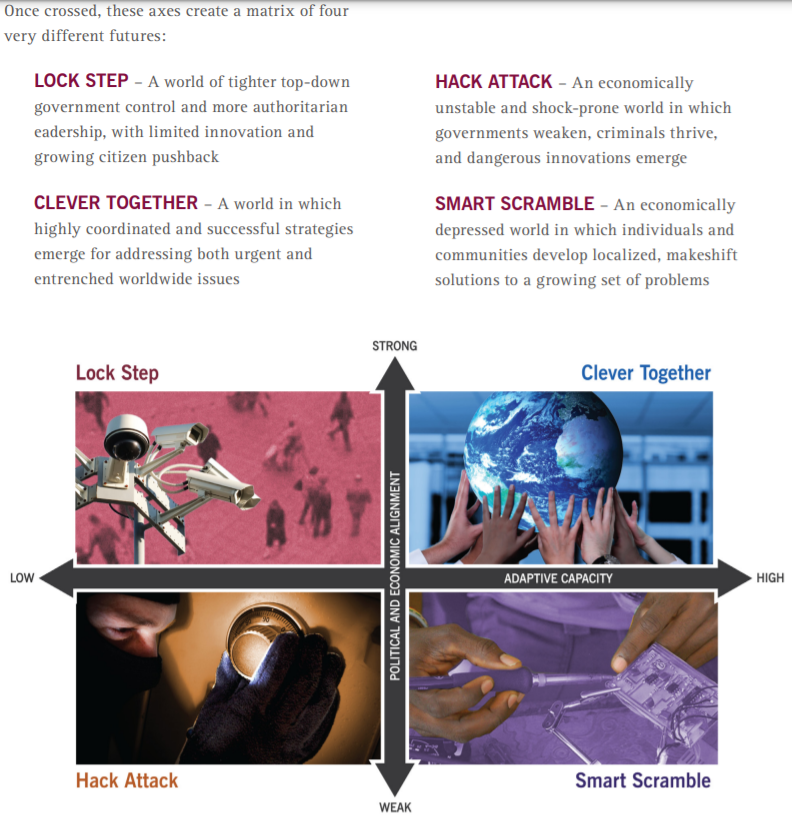
Source: “Scenarios for the Future of Technology and International Development” by the Rockefeller Foundation, 2010
Bearing in mind the report was a futuristic simulation run in 2010, one hypothetical scenario in the “Lock Step” section reads verbatim:
During the pandemic, national leaders around the world flexed their authority and imposed airtight rules and restrictions, from the mandatory wearing of face masks to body-temperature checks at the entries to communal spaces like train stations and supermarkets.
Even after the pandemic faded, this more authoritarian control and oversight of citizens and their activities stuck and even intensified. In order to protect themselves from the spread of increasingly global problems—from pandemics and transnational terrorism to environmental crises and rising poverty—leaders around the world took a firmer grip on power.
At first, the notion of a more controlled world gained wide acceptance and approval. Citizens willingly gave up some of their sovereignty–and their privacy—to more paternalistic states in exchange for greater safety and stability.
Citizens were more tolerant, and even eager, for top-down direction and oversight, and national leaders had more latitude to impose order in the ways they saw fit. In developed countries, this heightened oversight took many forms: biometric IDs for all citizens, for example, and tighter regulation of key industries whose stability was deemed vital to national interests.
Another part of the Rockefeller Foundation’s futuristic scenarios report describes (direct quotes below):
- Scanners using advanced functional magnetic resonance imaging (fMRI) technology become the norm at airports and other public areas to detect abnormal behavior that may indicate “antisocial intent.”
- Driven by protectionism and national security concerns, nations create their own independent, regionally defined IT networks, mimicking China’s firewalls.
- Governments have varying degrees of success in policing internet traffic, but these efforts nevertheless fracture the “World Wide” Web.
In the event of a technocratic dystopia, physical wars need not be fought.
“We are no longer mysterious souls; we are now hackable animals” — Yuval Harari, WEF 2020
On the international level, segregated data colonies would be able to render entire nations hostage via digital dictatorships.
On the national scale, brick-and-mortar correctional facilities could give way to open-air prisons that would restrict citizen access to basic goods and services at the digital flick of a switch, thus creating what historian Yuval Harari calls a “useless class” of people whose existence would no longer be relevant to those who control the flow of information.
All roads for tracking and tracing every person, purchase, and protein could also change what it fundamentally means to be human.
A transhumanistic future brought on by genetic alteration and the fusion of humans and devices, coupled with the adoption of digital identity schemes, could deepen social and geopolitical divides with the inevitable loss of fundamental human rights and democratic values if left uncontested.
“Welcome To 2030: I Own Nothing, Have No Privacy And Life Has Never Been Better,” reads one WEF-authored headline from 2016.
And with that, I’ll leave you with a quote from the WEF’s Global Risks Report from 2019, to sum up the gist of this article in one brief sentence:
“Authoritarianism is easier in a world of total visibility and traceability.”
A timeline of the great reset agenda: from foundation to Event 201 and the pandemic of 2020
Prepping for a cyber pandemic: Cyber Polygon 2021 to stage supply chain attack simulation
‘The great reset will dramatically expand the surveillance state via real-time tracking’: Ron Paul
Your digital identity can be used against you in the event of a great reset
How to hack a human 101: ‘organisms are algorithms,’ World Economic Forum Davos












